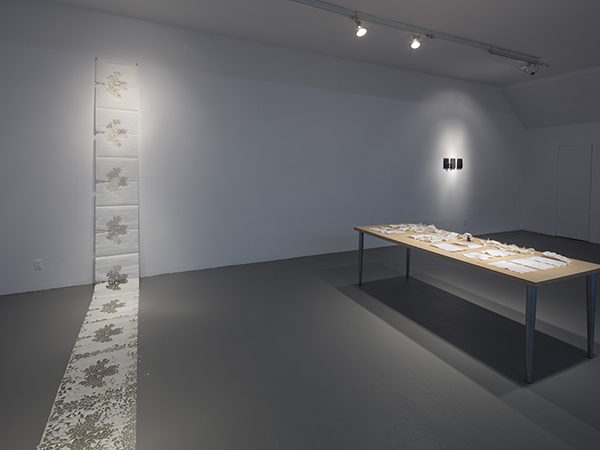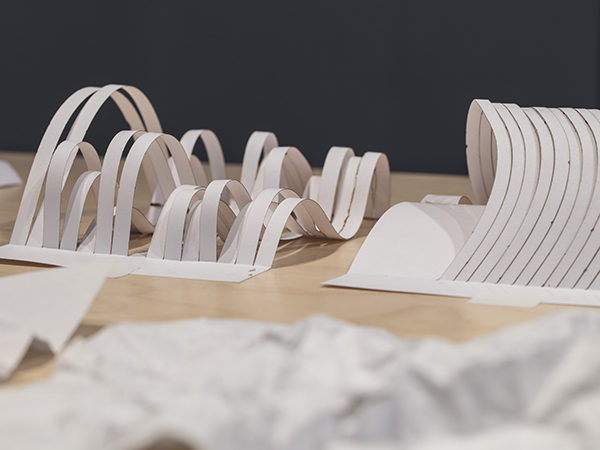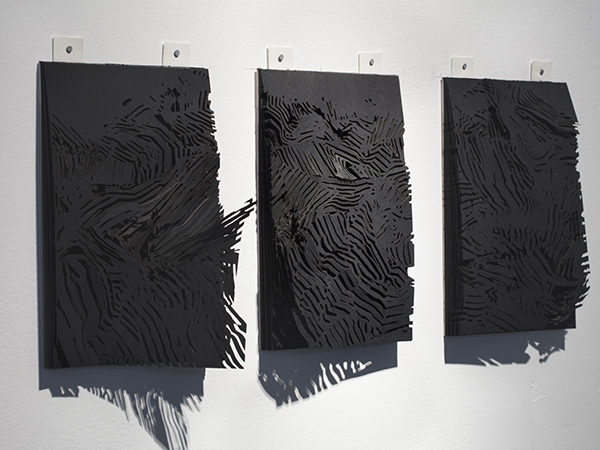Coral Bone / La mer
par Anne-Sophie Blanchet
Pavitra Wickramasinghe
from January 25 to March 4, 2018
Between January 22 and March 4 of last year, during the Mois Multi, LA CHAMBRE BLANCHE welcomed Montreal artist hailing from Sri Lanka Pavitra Wickramasinghe. Her multidisciplinary practice primarily revolves around design, video, sculpture and installation. Paper occupies a place of prominence, and it is precisely on furthering the use of this medium that the artist worked during her residency. Taking advantage of the technology and the tools put at her disposal, she carved, laser cut and transformed the paper to create a vast installation inspired by the sea, symbol of travel and discovery, into which viewers were invited to dive.

crédit photo: Ivan Binet
When entering the gallery, we firstly discovered a small table on which several small paper origami-like sculptures were displayed. They gave the visitor a foretaste of the vast possibilities of this material: spirals, fans, folding… Then on the right-side wall were disposed three anthracite blocks carved as to evoke rugged landscapes, topographic maps or waves in a bleak sea. Further, at the back of the room, the visitor’s gaze was attracted by a long ribbon, that hung on the wall and cascaded to the floor in a proliferation of rhizomes cut in a diaphanous white material. Finally, the visitor’s course ended with two paper squares lying side by side at our feet. The first one was tenuous; cuttings of organic forms turned into such delicate lace that it made us think of a complex weave of silk threads. The second square, devoid of cutting traces, was showing the still pristine pattern from which, we could guess, the first one was made.

crédit photo: Ivan Binet
Interested particularly by the issue of the image and the way it is looked at, Wickramasinghe’s practice is guided by the quest of wonder, the taste of the intrigue and the pleasure of discovery. In fact, in an interview during her residence1, the artist evoked a memory which while seemingly anecdotal, is a beautiful entry gate on her general approach as well as on the installation presented LA CHAMBRE BLANCHE.
When she was a child, she recalls one day catching her father taking apart the family’s television set to fix it. She was at once thrown in a state of wonder, because at that time she believed that the television shows actually existed in miniature form inside the set. Despite the rational explanation provided by her father and the unequivocal realization that the TV set was actually nothing else but a lot of wires and electronic circuits, young Pavitra remained puzzled. To see the mechanism hidden inside the unit had not enabled her to understand the process by which the images were formed, but quite the contrary, it seemed to her even more unfathomable.
During her residency, it is the very same state of astonishment that the artist wanted to recover and that she sought to arouse in the viewers. Thus, through a plastic research of an undeniable beauty, the paper laces scattered in the exhibition room induced a reflection that went well beyond strictly aesthetic considerations. It was rather the evocation potential of the material that was sublimated. Installation therefore arose as the result of a work and questioning of the conventions of the way we look at things.
She invited the spectators to observe alternatively the world that surrounds them; to see another potential in the objects and images that run through their daily lives. In fact, what can be more trivial and accessible than a paper sheet? Yet, the great malleability of this material enabled the artist to explore a host of shapes and textures. Crumpled, folded, cut, punctured, ripped, burned… a world of possibilities is born of a fragile material that is altogether fairly trivial and usually without great value.

crédit photo: Ivan Binet
These last considerations allow us to weave links between Wickramasinghe’s installation and the theme of the nineteenth edition of the Mois Multi; the re-enchantment of the world. After all it is by discovering and exploring a certain potential that the artist managed to capture the onlooker’s gaze and to pique their interest, arousing surprise and delight. However, this re-enchantment issue can also be seen from a different level. Indeed, if the onset goal of this residency was largely based on the formal exploration of the opportunities and limits of paper, the approach underlying this exercise was nevertheless a reflection begun several years ago around the sea as a symbol. Sublime expanse sometimes calm, sometimes raging, the sea bears life; it is the way we use to travel and explore the world; it inspires both hope and fear; oblivion and absolute.

crédit photo: Ivan Binet
Through this symbol, the artist addresses an important part of her personal genesis, that of a child who, at the age of 12, crossed the ocean with her family to settle in Canada. Since then, forever travelling, the concept of a “home” seems rather relative. Indeed, what is this “home” if she doesn’t feel she belongs to a land? How to reconcile the need to settle and the desire to set sail? How to quench her thirst for discovery while overcoming the need she feels when she is away from her family? Water, the sea, these in-between lands thus become a home port as if in exploration and movement she finally feels she coming home.
Knowing that Wickramasinghe’s practice is rooted in an intimate and very personal approach, the installation presented at LA CHAMBRE BLANCHE proposed a reflection on this “in-between”. If nothing was actually moving in the gallery, we could still easily imagine that all the elements exposed were in a state of full metamorphosis… a crumpled paper that can be uncrumpled, a pristine pattern can be cut out, a tangle of ribbons may be unravelled. Once more that artist seems to invite the spectators to explore the world surrounding them, dares them to be inquisitive and to exploit the full potential of wonder that, sometimes is hidden in the most mundane of the day-to-day.
- Interview given by Anne-Sophie Blanchet on August 17, 2018.